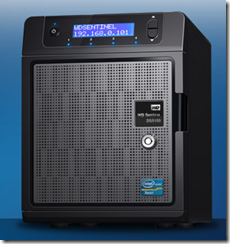Richard Tubb's Blog, page 93
November 20, 2013
The value in learning to say No
 What is the value in learning to say no?
What is the value in learning to say no?
Have you ever had somebody tap you on the shoulder as you were in the middle of a task that required your concentration, or call you on the telephone just as you were about to get on with something important? When the person asks you for whatever it is they want help with, how do you normally respond? I’m guessing it’s not unusual for you, like me, to use the turn of phrase “Just give me 5 minutes”.
Of course, what you’re trying to say is “I’m busy right now” but you’re probably too polite to say that. So you set their expectations in that you’ll be no more than 5 minutes at which point you’ll be able to help them. The trouble is that if you take longer than 5 minutes to get back to that person then they may feel as thought you’ve let them down and you’ll probably feel the same way. Not a great way to start a conversation.
Saying “Yes” when you really want to say “I’d love to be able to help, but I’m unable to right now” is something many of us struggle with. I, along with many others, find it difficult to say “No” for fear of letting the other person down, yet the reality is that by saying “Yes” and then failing to deliver what you’ve promised – you’re letting the person down much more.
Setting Unrealistic Expectations
I’ve recently said “Yes” when, with hindsight, I meant to say “No”. It caused stress (for me) and frustration (for the person I’d say yes to).
During the month of October I was on the road travelling for business almost solidly. I emailed my paying clients in September to advise them October would be very busy and so be aware I may be slower with responses to my email than I normally was. All my clients understood – I had set their expectations correctly. If only I’d done that with everyone else!
I set an out of office message on my email to advise everyone who contacted me that I’d be very busy travelling and unless they were a paying client that I’d be unlikely to be able to respond to them in a timely fashion. So far so good. I then made the mistake of sharing shared when I’d be back in the office and the day I’d specifically put time aside to catch-up on emails. I set expectations. Expectations that were, in hindsight, unrealistic. Expectations that I’d set because I felt bad telling people that I may take longer to reply to their emails.
(I typically work to the calculation that for every full day I’m out of the office, I need an hour specifically to catch-up on emails upon my return. So seven days out of the office = a whole working day to catch-up on emails. On this occasion I was out of the office for almost 3 weeks, which realistically meant I’d need 3 full days to catch-up on e-mail. “Nah!” I thought “A day should be fine!”).
Suffice to say that three weeks later and having spent just a day tackling the job of taming my email that was, in reality, a 3 day job — and then thrown back into the daily routine of new emails and fee earning work — I’d barely made a dent in the hundreds of requests for my time I’d received.
The consequences of breaking promises
 Malcolm, the owner of an IT business, was one of those people who emailed me while I was travelling to ask for help and who I regrettably didn’t respond to in a timely fashion. Understandably, given how I’d incorrectly set his expectations with my out of office message, Malcolm emailed me much later on to say “Well that’s disappointing – I sent this email more than three weeks ago and you didn’t keep your promise. You were possibly the solution to opportunities lost, but hey ho.”
Malcolm, the owner of an IT business, was one of those people who emailed me while I was travelling to ask for help and who I regrettably didn’t respond to in a timely fashion. Understandably, given how I’d incorrectly set his expectations with my out of office message, Malcolm emailed me much later on to say “Well that’s disappointing – I sent this email more than three weeks ago and you didn’t keep your promise. You were possibly the solution to opportunities lost, but hey ho.”
Malcolm was right. I’d set his expectations, or made a promise, to get back to him three weeks earlier and hadn’t.
I’m guessing that if my out of office message was more realistic and actually said “I’d love to be able to reply to your email in a timely fashion, but the reality is that I receive so many emails that I’ll be unable to” that Malcolm would have been disappointed with my response and yet got over it and moved on. I may have even exceeded his expectations by responding three weeks later with a polite “Can I still help you?” when he probably didn’t expect a response at all.
Of course, I apologised profusely and went out of my way to subsequently offer free advice and help to Malcolm – but I never heard back from him. The damage had been done. I’d lost all credibility in Malcolm’s eyes.
A lesson learned for me and one you can learn from too, I hope.
Learning to say “No”
In your own business, how often do you say “Yes” to clients and prospects when you really meant to say “No” — then reap the consequences of putting pressure on yourself and setting your clients/prospects expectations too high to realistically meet?
It may be a friend or family asking for assistance when you’ve already got commitments elsewhere.
It may be a client who wants immediate help when you’re already booked up solidly.
It may be a prospect who asks for something which you’re unsure you know how to deliver upon.
I’m a helpful person by nature so I’m trying hard to learn to say “No” more often where my gut feeling is that I’m not going to be able to help that person in a timely fashion or indeed at all. It’s neither helpful to me nor the person to set their expectations unrealistically.
Saying “No” may disappoint the person you’re saying it to, but they’ll understand — and better to politely say “No” early on than say “Yes” and not meet your commitment later on.
photo credit: cheerfulmonk via photopin cc
photo credit: @andymatthews via photopin cc



November 15, 2013
Joindre un groupe local de pairs: trois avantages pour votre entreprise

Last year I wrote a blog post about Managed Service Providers in German. This year to celebrate the European Multilingual Blogging Day 2013 I have asked my friends at Writers Block Admin Services to help me post a blog in French!
L’an dernier j’ai écrit un blog en allemand au sujet des prestataires de services, cette année, pour fêter le Jour du Bloggage Multilingue Européen 2013 , j’ai demandé à mes amis Writers Block Admin Services de m’aider à écrire un blog en français!
***
Octobre a été un mois chargé pour moi dû à ma présence à un certain nombre de conférences informatiques spécialisés dans les prestataires de services informatiques pour petites entreprises – la plus grande étant Autotask Community Live! 2013 à Barcelone, Espagne.
Beaucoup de prestataires de services informatiques à Community Live que j’ai rencontré avaient voyagé depuis la France jusqu’en Espagne pour passer du temps avec leurs pairs – échangeant des notes, des idées et leurs meilleures méthodes qu’ils ramènent alors chez eux pour aider leur entreprise à s’agrandir.
Plus d’un prestataire de services à qui j’avais parlé à la conférence a depuis partagé avec moi le fait que mettre en œuvre les choses qu’ils avaient appris lors de la réunion à leur entreprise a eu un impact majeur sur leur entreprise – leur faisant gagner du temps et les aidant à faire d’avantage de profit.
Assister à un groupe local de pairs
Autotask Community Live et d’autres conférences similaires n’arrivent qu’une fois par an. Mais pourquoi ne pas saisir ce genre d’impact décrit par ces prestataires de services plus d’une fois par an? Pourquoi ne pas le faire durant toute l’année?
Ca peut se faire – à travers les groupes de pairs organisés localement.
Alors que je peux comprendre que les groupes d’utilisateurs – des communautés construites autour de vendeurs tels que VMWare or de technologies telles que C++- soient un concept populaire en France, les groupes de pairs – où les entrepreneurs d’un même milieu se rencontrent régulièrement pour apprendre l’un de l’autre ne sont pas aussi populaires.
Qu’est-ce que j’y gagne?
Il est compréhensible que les propriétaires d’une entreprise d’informatique, qui sont toujours très occupés, se demandent pourquoi est-ce qu’ils se rencontreraient tous dans une salle avec les propriétaires d’autres entreprises – certaines d’entre elles étant concurrents!
Ma propre entreprise de prestataires de services a été construite grâce à mon active présence dans des communautés de groupes de pairs comme ceux-là. J’ai réalisé qu’être un membre d’un tel groupe de pairs ne consistait pas à donner tous vos “secrets d’entreprise”, mais de bénéficier d’un certain nombre d’avantages pour votre business informatique:
Restez à jour au sujet des derniers produits, tendances et idées dans l’industrie informatique bien plus efficacement que si vous étiez tout seul. Avec vous vraiment le temps de lire tous ces magazines et newsletters pour vous remettre à jour?
Surmontez les défis professionnels bien plus efficacement. Chaque défi que vous devez surmonter, que ce soit professionnel ou technique, a sûrement déjà été résolu par un collègue. Inutile de refaire ce qui a déjà été fait. Apprendre des autres vous aidera à accélérer votre croissance.
Construisez des alliances stratégiques avec d’autres entreprises informatiques. Vous pouvez mettre en commun vos ressources ou vous pouvez offrir de la sous-traitance spécialisée comme de la Wi-Fi, du VoIP et des Télécoms. Etendre votre réseau de cette manière vous offrira beaucoup de puissance et flexibilité à votre entreprise.
Conclusion
Les avantages qu’il y a à assister à un groupe local de pairs sont clairs et les désavantages sont minimes. Si vous avez vraiment envie de faire croître votre entreprise informatique et vous avez la possibilité d’assister à un groupe de pairs en France, je vous encourage sincèrement de le faire!
Et s’il n’y a pas de groupe local de pairs dans votre région en France, pourquoi ne pas en créer un? Vous serez au centre d’un réseau croissant d’entreprises informatiques, toutes axées aussi sur la croissance!
Je serais ravi de vous connecter avec de telles entreprises qui aimeraient collaborer de cette façon – merci de me joindre ici.
photo credit: MrSchuReads via photopin cc



November 11, 2013
How To Use Social Media To Be More Effective At Your Job
 A heads-up that I’ll be joining my good friend Cathy Alper of CompTIA, along with Ginger Clay of 4-Profit for a free webinar this Thursday 14th November 2013 at 4pm GMT (10am CST) where we will be discussing How To Use Social Media To Be More Effective At Your Job.
A heads-up that I’ll be joining my good friend Cathy Alper of CompTIA, along with Ginger Clay of 4-Profit for a free webinar this Thursday 14th November 2013 at 4pm GMT (10am CST) where we will be discussing How To Use Social Media To Be More Effective At Your Job.
I’m excited about the webinar because while most of the webinars I typically participate in are aimed at IT business owners, this webinar will focus on the personal use of Social Media for success and being effective in your professional role. In other words, it’s going to provide value for anyone – regardless of the type of work you do!
How to Register for the Webinar
Registration for the How To Use Social Media To Be More Effective At Your Job webinar is free and open now. I hope you can join us!
photo credit: Jason A. Howie via photopin cc



November 8, 2013
Friday Favourites – 8th November, 2013
 On a Friday I try to post my favourites from the week – links to cool content and tools that I’ve found or had recommended to me.
On a Friday I try to post my favourites from the week – links to cool content and tools that I’ve found or had recommended to me.
Cool stuff I’ve found this week, ending 8th November, 2013:-
Mover.Io – The smarter way to move files between Cloud storage providers such as DropBox, Google Drive and Box. Does away with the need to download and then re-upload files between services – instead moving them directly.
Chirp.io – Let’s teach the machines to sing! Innovate way to transfer pictures and files between mobile devices using high pitched modem-like noises (if you’re old enough to remember dial-up modems!). Has to be seen heard to be believed!
QlikView – Self-Service Business Intelligence (BI). Consolidate relevant data from multiple sources into a single view. Thanks to Autotask Certified Consulting Professional Emma Barker for sharing!
Do you have any cool content or tools to share with me? Why not e-mail me, Tweet me, or share with me on Google+ and I if I feature them in my blog you can be sure to give you credit!
Have a great weekend! 
photo credit: mdalmuld via photopin cc



November 1, 2013
Friday Favourites – 1st November, 2013
 Friday Favourites returns! Each Friday I try to post my favourites from the week – links to cool content and tools that I’ve found or had recommended to me.
Friday Favourites returns! Each Friday I try to post my favourites from the week – links to cool content and tools that I’ve found or had recommended to me.
Cool stuff I’ve found this week, ending 1st November, 2013:-
ToneCheck – ToneCheck allows you to do a quick once over check over your emails to prevent you from accidentally saying something that you might regret! Flags negative tone automatically. A free plug-in for Gmail, Microsoft Outlook and Lotus Notes.
Focal Camera – From the team at Cyanogenmod, a fully featured camera app for Android that is looking to provide the most features as possible. Still in Beta.
Chimpadeedoo – Mobile signup forms from MailChimp. Collect mailing list sign-ups at events or meetings using your iPad or Android tablet. Stores data locally for when you’re not online. Thanks to Karen Strunks for sharing!
Do you have any cool content or tools to share with me? Why not e-mail me, Tweet me, or share with me on Google+ and I if I feature them in my blog you can be sure to give you credit!
Have a great weekend! 
photo credit: Sangudo via photopin cc



October 31, 2013
Avoid the “Takers” – those people who steal your time and energy
 When you see them, do you avoid the “Takers” – those people who steal your time and energy?
When you see them, do you avoid the “Takers” – those people who steal your time and energy?
We’ve all encountered these type of people at sometime or another – perhaps without even knowing it. They can sometimes be hard to spot.
The person who sells you on a wonderful business opportunity – but behind the scenes manipulates the situation to their advantage.
The individual who is seemingly friendly or helpful when they want something, but who never seems contactable when you need their help.
The prospect who wants to ask question after question, but is never prepared to pay for your time.
The client who wants an instant response when he has a problem, but avoids your calls when their bill is overdue.
The “Takers” are the people who want to take advantage of us and deceive us.
A Transparent World
Thankfully, as Ma Tubb would say, “The Truth Will Out”. Given the transparent world we now live in, these “Takers” find it more difficult to survive. It’s difficult to not reveal your true self on Social Media. Burnt bridges are spotted from miles away by many people. Word (both positive and negative) spreads much more easily in the Digital Age. Despite this though, these “Takers” are something we all still have to deal with.
It’s easy to become jaded. To think the world is out to get you. That’s simply not true. 9/10 people you will meet are open, honest and genuine. Don’t let the “Takers” – the 1/10 of people you meet – sour you on going into other business relationships with a positive attitude. Treat new relationships with trust and you’ll be rewarded.
Move away from the Takers
But do learn from your mistakes. When you spot a “Taker” – move away from them. Quickly. Don’t waste time or energy thinking about them or dealing with them.
Don’t try to convert them into good people. Don’t give them multiple chances. If you spend time with the “takers”, you’ll lose energy and enthusiasm, you’ll start to become jaded and you’ll become suspicious of and radiate negativity to others around you – even if you’re not aware of the fact that you’re doing so.
Conclusion
The world is full of people who you can trust, who you draw energy from being around and who make you happy. Seek them out. Spend time with them.
You become like the people you spend time with. Be they friends, colleagues, business associates, suppliers or clients.
Make sure you’re spending time around the right people and feel the benefits of doing so.
photo credit: origami_potato via photopin cc



October 21, 2013
Looking at Autotask Community Live 2013 in Barcelona
 Last week and for the first time ever, Professional Services Automation (PSA) software company Autotask brought their Autotask Community Live! event to Barcelona, Spain.
Last week and for the first time ever, Professional Services Automation (PSA) software company Autotask brought their Autotask Community Live! event to Barcelona, Spain.
Some 300+ attendees – the majority of whom were IT Solution Providers and Managed Service Providers (MSP’s) from Europe and the UK, but with guests from Australia, the Middle East and North America – enjoyed a Conference spread over three days, including a full day of “Boot Camps” for existing Autotask customers who wanted to take a deep dive into the product.
I was fortunate enough to be asked to attend and host two sessions at this years event, and had some interesting and insightful conversations. Here’s a brief overview of what I took away from the event.
Mark Cattini Keynote
During his keynote presentation, Autotask CEO Mark Cattini shared that
Autotask now has some 11,000 users globally
The growth in Autotask’s International user-base has been explosive – in 2011 some 28% of users were International, 72% from North America. Fast forward to 2013 and 60% are International, 40% North America.
Cattini also noted that for any Vendor looking to enter a local market, the lessons Autotask have learned are clear:-
It’s not just about translation, but localisation.
Implementation can’t be done over the phone from the US, it needs to be done locally. You need feet on the ground.
Offer support in a local timezone with a local number.
The Autotask Economy
 Also during his keynote, Cattini also shared that one of the benefits of Autotask’s Software-as-a-Service (SaaS) approach is that it enables them to perform wide ranging analytics on the devices MSP’s and their clients use.
Also during his keynote, Cattini also shared that one of the benefits of Autotask’s Software-as-a-Service (SaaS) approach is that it enables them to perform wide ranging analytics on the devices MSP’s and their clients use.
Worldwide, Autotask clients manage approx 20 million devices including Servers, Desktops, Smartphones and Tablets.
This year within Autotask, its European users will generate an estimated 700 million Euros
In 2013 Autotask’s European clients will process 8 million tickets. Worldwide, Autotask users will manage an estimated 30 million tickets - that’s 1 ticket every second.
SMB’s are moving to Emerging Services
Cattini went on to explain that he believes the balance between traditional and emerging services is shifting.
Traditional Services – IT Consulting, Systems Integration, Outsourcing.
Emerging Services – Security as a Service, SaaS, Cloud, Services integration.
Some 15% of total services globally are now comprised of emerging services. Cattini advises that this figure is growing year on year and it can’t be ignored. By 2020 emerging services will be around 40% of total services. The lesson to be drawn from these statistics? Customers like the Pay-as-You-Go model or as Meg Whitman – CEO, HP said “There is a Tectonic plate shift in the way technology is consumed, delivered and the way it is paid for, and my view is that this happens every 10 to 15 years in our industry.”
Areas for IT investment
Continuing his keynote presentation, Cattini offered up 3 major categories for IT investment.
Mobile $181 billion by 2017 – up 15%
Big Data $53 billion by 2017 – up 58%
Cloud $121 billion by 2015 – up 26%
As a side-note, Cattini also shared with me before the event and again during his keynote that he believes there is a search in the mobile device market for an “unconsciously portable device” – citing the shift towards smaller tablets as an indicator. This, he believes, will be the next breakthrough.
Cattini went on to challenge the growth in Big Data and ask how is this relevant to SMB’s? “Let’s look at small data” including Real-Time analytic processing and helping SMB’s understanding how to leverage KPI’s within their business.
“At Autotask, every single day we find a new way of looking at our business” Cattini offered.
What is Smart IT?
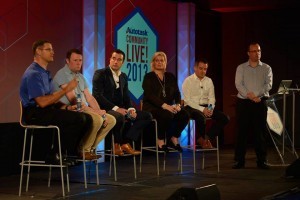
The idea of “Smart IT” permeated Cattini’s keynote.
“Technology for it’s own sake is merely interesting. The reason you deploy a mobile solution is to increase satisfaction. The reason you use Big Data is to improve profitability. The reason you deploy Cloud is to improve productivity. Smart IT is using technology to deliver positive business outcomes for your customers and yourselves.”
For me this was the key takeaway from the Conference. For years the IT industry has been talking about the need to focus on benefits, not features. Cattini and Autotask have found a strong way of emphasising this view, in my opinion and one that was re-iterated in my own panel session (pictured right) featuring industry experts later in the event.
The Autotask Roadmap
Of specific interest to those Autotask MSP’s in attendance was news on the Autotask Roadmpa.
“Product Management is the most difficult job in our business.” Cattini said during his keynote and shared that it took him a long time to understand how important Product Management was. He understand it now.
Going on, Cattini shared that Autotask have multiple inputs for suggestions and they now have a standardised disciplined approach to prioritisation of product improvements. In 2013 this will see (or has already seen) enhancements such as:-
Adoption of ITIL standards. This was the 2nd most requested feature by International customers. ITIL supports the Smart IT ethos of continuous improvement. ITIL Incident Management has been implemented within Autotask and Change Management will be implemented into product in January 2014.
Increased granular security across many modules of the Autotask tool.
Increased Local market flexibility. The new Autotask Invoice Template Editor is released this month (October). There are additions of Custom Address format, a Tax Category matrix and ISO Country Standardisation too.
Enhanced Efficiency and Usability including the addition of the Time entry stopwatch as well as 100’s of small usability improvements.
Service Intelligence improvements including the Livereports Custom Designer which enables you to gain a unique insight into your business.
“Tell us what you need and we’ll prioritise it” shared Cattini.
New Autotask UI
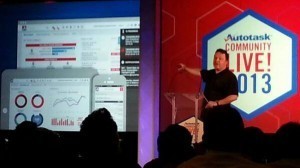 The biggest Product news coming out of the event was Cattini’s announcement of a completely re-built User Interface (UI) for the product.
The biggest Product news coming out of the event was Cattini’s announcement of a completely re-built User Interface (UI) for the product.
“We’re going to design a modern, elegant, beautiful UI. It’s going to drive productivity, learn-ability and consistency. We’re re-imaging the PSA category to deliver on the promise of Smart IT”.
In the closing statement of Cattini’s keynote he offered “Autotask is complex. It’s a business management platform. But it should not be, and doesn’t need to be complicated. Usability shouldn’t be a constraint in driving value from the system.”
Autotask brings US style Conferences to Europe
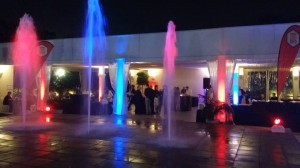
On a personal level, I’ve long suggested that we don’t do SMB Conferences well here in Europe. They tend to be unambitious, flat and missing the “buzz” of the equivalent US Conferences I’ve attended.
Autotask have now broken this mould – Community Live felt huge, drawing visitors from all over the world with a thriving Vendor presence that was well utilised throughout, tons of interesting sessions from genuine experts in their field, and an amazing venue in the 5 star Hotel Rey Juan Carlos – the site of a former Olympic Village.
 Then there were the parties! Autotask made this a memorable event – offering up Razzmatazz that will long last in the memory. Even if many heads were a little sore the next morning…
Then there were the parties! Autotask made this a memorable event – offering up Razzmatazz that will long last in the memory. Even if many heads were a little sore the next morning… 
There is so much effort put into these events from Autotask as a company with resources allocated to organising this show almost 365 days in advance. This doesn’t go un-noticed by attendees – the show ran on-time and flawlessly. I genuinely didn’t hear a negative comment of note about the show. Improvements, sure, but everyone found the event valuable.
Autotask Community Live! 2014
Thoughts now turn to Autotask Community Live! 2014 which takes place in Miami, FL in the USA. The European event will return again in 2014 too. Where? That’d be telling – but you can rest assure Autotask Community Live has established itself as an industry “must attend” event for Vendors and MSP’s alike.
Photos courtesy of Nordic Solutions, Len Dicostanzo and Susanne Dansey - thanks for sharing some awesome pictures!



October 16, 2013
Is your MSP offering Storage plus Server or Disaster Recovery as a Service?
Is your MSP offering Storage plus Server or Disaster Recovery as a Service?
Storage Vendor giant WD, who many of us will be more familiar with as the business formerly known as Western Digital, are making some interesting moves that your IT business should be aware of.
Primarily known as a manufacturer of Hard Drives, in recent times WD have moved into the Business Storage Solutions market and announced a range of Servers aimed at the Small and Medium Business (SMB) market. This now puts them into conversations that SMB IT Solution Providers and Managed Service Providers (MSP’s) would previously only had with HP and Dell.
Storage plus Server
Take the WD Sentinel DS range. With a small form factor you might mistake it for a simple Network Attached Storage (NAS) device. A closer look reveals some pretty powerful hardware under the bonnet and running Windows Server 2012 R2 Essentials the DS is not only capable of networking file sharing, but also automatic client computer backup for any machine connected to the LAN, and very importantly – the ability to run Line of Business (LoB) applications. So it’s a powerful NAS and it can run LoB Apps – or as WD label the concept, “Storage plus Server”.
That’s interesting because increasingly many SMB clients feel they don’t need a server beyond file storage. They are hosting e-mail in the Cloud, they are using web-based applications and if they could do away with their server and replace it with a NAS they probably would. The trouble is, they often still need to run LoB apps. WD’s “Storage plus Server” concept offers an interesting alternative to the Server plus NAS setup – and I think it’s worth MSP’s being aware of as a potential solution for their SMB clients.
Network Backup
Then there is the fact that WD also offer a range of Network Backup Appliances and Network Backup Software. Oh, you didn’t know WD did Backup Software? Then you’re not alone!
The WD Arkeia network backup software is a fully featured backup tool to rival Symantec Backup Exec or Arcserve. It supports backups of physical and virtualization servers, offers Hybrid-Cloud features (perform backups to disk on LAN’s and then replicate the backups to the Cloud) and has agents for over 200 platforms including as Windows, Mac and Linux.
The WD Network Backup Appliance range promise high reliability but with only minimal maintenance. What does that mean for MSP’s? Well, consider the option of putting a Network Backup Appliance device on a client site for local backups, then replicating the data to another device in your own Data Centre to provide a Backup and Disaster Recovery Solution that can generate recurring revenue for your MSP business. It’s certainly a more sophisticated way of offering DR-as-a-service than doing local backups to a dumb NAS with server based backup software, then transporting that data off-site using other software. The idea of having all the on-site and off-site components under one roof from a single Vendor should reduce the cost of support and mean MSP’s have to do less maintenance too.
Interview with Tom Gallivan, VP of WD
While in Barcelona, Spain attending the VMWorld and Autotask Community Live! Conferences this week, I was fortunate enough to be able to chat with the Vice-President of WD, Tom Gallivan to understand more about what WD are doing in the SMB space. I asked Tom why WD were moving into the SMB market, how IT companies can use WD products to drive service sales and increase recurring revenue, and to understand how WD are supporting their partners in the UK.
Thanks to Tom Gallivan for taking the time out of his VMWorld visit to speak to me, and I hope you learn a lot about how your IT business could benefit from our conversation which you can view below.



October 11, 2013
4 Easy Ways To Work The Room At An IT Conference
 It’s currently “Conference Season” in the IT industry with the opportunity to attend a multitude of valuable IT Conferences across the globe.
It’s currently “Conference Season” in the IT industry with the opportunity to attend a multitude of valuable IT Conferences across the globe.
I openly attribute much of my success in running an MSP from attending such Conferences. Attending these events accelerated my growth as a business owner. It allowed me to spend time meeting new people and learning from some of the most successful individuals and businesses in the industry. It helped me forge long-standing relationships and bring back tips and advice that it may have taken me years for me to learn on my own. In short, the investment of time and money I made by taking time out of the office to travel to conferences was invaluable.
With that said, I wouldn’t have realised nearly as much of that value if I hadn’t overcome my fear of meeting new people. I didn’t (and still to a great degree don’t) enjoy networking events of any sort. The thought of entering a room full of strangers will have me breaking out into a cold sweat. It’s still really easy for me to find a single familiar face at a Conference and fall into the trap of spending all my time having the same conversations with someone I already know. Or worse, be “that guy” stood in the corner of the room desperately pretending to be busy on his Smartphone so he can avoid talking to anyone.
Over the years though, I’ve picked up a few techniques to help me step outside my comfort zone, meet new people and feel comfortable in conversation. Here are my 4 ways to “Work The Room” at an IT Conference.
Look for an open conversation
When you’re looking for a conversation then look for an “open” group that you can join, not a “closed” one.
A closed group would be where two people are stood facing each other straight on, or a group of people have formed a inward facing circle and are talking intently. They have something important to discuss and are focused entirely on each other. Don’t be that person who hovers nearby, desperately looking for a gap in the conversation so you can introduce yourself. That gap in the conversation might be a long time coming!
An open conversation is where two or more people are chatting and standing in an open semi-circle – subconsciously inviting someone else to join them. The conversation is not intense and you’ll find that either there will be a lull in the conversation where you can easily introduce yourself to others, or just as likely, somebody else in the group will smile and introduce themself to you.
Make it all about them
It’s worth remembering that everyone’s favourite topic is themselves! Who doesn’t like to talk about themselves, right?
When meeting someone, try to resist the urge to talk about yourself and instead use the opportunity to learn about the other people, asking questions about them instead. “Small talk” is fine – where they travelled from to reach the Conference, have they attended the Conference before, etc. but consider asking them what they hope to get from attending the Conference, what they are looking forward to on the agenda, and what impact they hope the Conference will have on their business.
As well as learning more about them and their business, you may find you share a lot in common between you that you can learn from yourself.
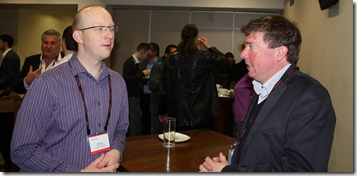 Be The Connector
Be The ConnectorDuring the course of the conversation, and indeed during the Conference as a whole, look for opportunities to introduce people to one another based on commonality.
For instance, if one person tells you they specialise in Voice-Over-IP (VoIP) and another tells you they are looking to get into providing VoIP solutions to their clients – connect them both up! If one person shares they are currently implementing a PSA tool, and another shares they are considering implementing a PSA tool – make the introduction!
By looking for opportunities to “Be The Connector” and introduce people to one another, you’ll be adding value to every conversation you have and every relationship you form. What’s more, it’s human nature to try to reciprocate. Don’t be surprised if those same people find you during the Conference and introduce you to people that they think you will find valuable to meet.
When the Conversation Ends
If and when the conversation runs to its inevitable conclusion and you are both left with that awkward silence and it seems like there is nothing more to say, you could of course excuse yourself and make a bee-line for the toilet. Or indeed you could answer a phantom mobile phone call from “the office”. Or you could avoid all that awkwardness and use this phrase instead.
“I’d imagine you know a few people here?”
If the answer from the other person comes back “Yes” then share with them that you don’t know many people and so you’d find it really valuable if they’d mind introducing you to some new people. In this way you’re giving the other person the opportunity to “Be The Connector” themselves!
If the answer comes back “No!” and they don’t know anyone – then nod and share that you’re in the same boat and suggest that perhaps you both go and meet someone together.
You can then use the technique I shared at the start of this post and find an individual or open group of people to introduce to your new contact!
Conclusion
Attending an IT Conference is a big commitment in terms of time and money. The rewards from attendance are that it can be of huge benefit to both your business and personal growth. You can meet new people and find valuable new ideas – and to do so you may have to step outside your comfort zone and face a room full of strangers.
You can avoid falling into the trap of chatting with the same group of people by looking for an “open group” and then being brave for 30 seconds and starting a conversation with someone new. Focus on that person during the conversation and find common ground and new ideas. Remember to look for opportunities to “Be the Connector” and realise that by doing so you’ll add value to the conversations you are having with people and making it easy to build new relationships.
Enjoy Conference season – and if you see me in the room, come and say hello!
No stock photography here! These snaps were taken from the CompTIA UK Channel Community meeting in Cardiff. 



September 20, 2013
Friday Favourites – 20th September, 2013
 On a Friday I try to post my favourites from the week – links to cool content and tools that I’ve found or had recommended to me.
On a Friday I try to post my favourites from the week – links to cool content and tools that I’ve found or had recommended to me.
Cool stuff I’ve found this week, ending 20th September, 2013:-
Pause – Do you ever wonder if you’re tied to your Smartphone too much? Use the App to pause your Smartphone and stay offline to read a book, have an uninterrupted cup of tea or just relax! Time spent offline is tracked and you can compete with others to see the amount of time you spend offline. Available for iOS and this week was also released for Android too.
Keebo – Spend less time dealing with receipts and invoices and more time achieving your business goals. Go paperless and store your receipts in the cloud. Thanks to Michael Freeman of Southern IT for the link!
PlaceMe – Always remember where you’ve visited. Available as an App for iOS and Android, allows your Smartphone to automatically register where you’ve visited with no check-in’s required. Totally private – your location is never broadcast – and it’s quick and easy to search all your visits.
Do you have any cool content or tools to share with me? Why not e-mail me, Tweet me, or share with me on Google+ and I if I feature them in my blog you can be sure to give you credit!
Have a great weekend! 
photo credit: rachels1221 via photopin cc




